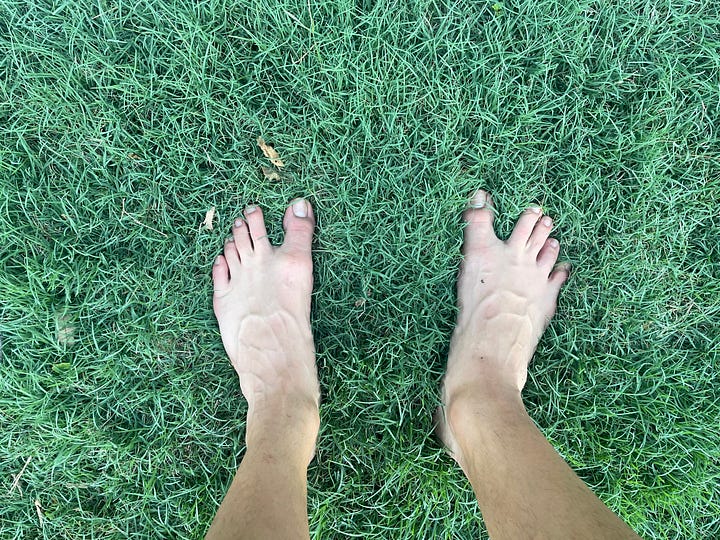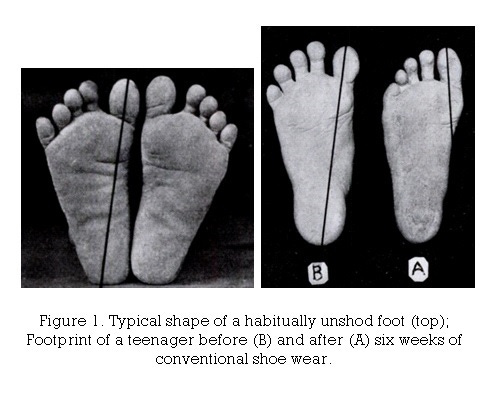It's Time to Ditch Modern Footwear
A history on shoes, where they went wrong, and why you should go barefoot as much as possible
Think back to the last time you explored a new city from sun up to sun down or had to be on your feet for work all day. Or for the outdoorsy folks reading this, when you hiked all day long and finally got back to camp. What was the best feeling after all of that?
Taking off your shoes, right? Why is it that if we spend all day in shoes, our feet feel awful? And why is the sweetest relief in the world taking your shoes off and wiggling your toes after a long day?
Last week, we talked about how much the clothes we wear, particularly the fabric used to make them, have drastically changed over the last 120 years. Like clothing, shoes have undergone a major makeover in form and function. Unfortunately, shoes are just as detrimental to our health as synthetic fabric.
Fortunately, there are things we can do to minimize or even reverse the health impacts that shoes are having on our feet, our health, and the planet.
A brief history of shoes
It’s likely that humans have been wearing shoes for at least 40,000 years, so they can’t be all bad, right? Well, even though shoes have been around for quite some time, this doesn’t mean that they were commonplace to wear.
In fact, the ancient Greeks didn’t wear them much at all. In Roman times, shoes were worn by the legions, but not so commonplace for the everyday citizen.
During the Middle Ages, shoes were a bit more common, but they were made on a more individual basis and usually of natural materials.
Where shoes went wrong and why
It wasn’t until the 16th and 17th centuries that shoes with heels were invented and began being worn by both men and women to enhance their height, posture, and gait.
In the 19th century, namely, during the industrial revolution, mass-produced shoes became more commonplace due to advancements in technology. In fact, the style of shoes born in this time period still persists today.
It was likely during this period of 300 years that foot health began its percipience fall. By starting to wear unnaturally shaped shoes, our toes and the tiny muscles in our feet no longer had to do as much work, becoming weaker.
Health consequences of wearing shoes
In order to explore the health benefits of barefoot walking, we first need to understand the health consequences of always wearing modern shoes.
When you wear shoes, especially tight-fitting ones, it forces all of your toes together, reducing the mobility and individual dexterity of each one. It would be like putting on mittens and making your fingers all work as one instead of giving each finger the opportunity to shine in the things it does best.
Secondly, we have bunions. Bunions are caused when the big toe is pushed towards the second toe. This is more common in older women nowadays and you have to wonder if that’s because of how much that generation wore tight-fitting heels for most of their professional lives.
This smashing of the big toe towards the second toe causes overpronation of the foot (angling inwards), leading to arch collapse and flat feet. Flat feet then lead to a host of health problems such as knee pain, hip pain, and bad posture.
Modern shoes don’t allow your foot to sit flat on the ground either. If you look at a shoe in your closet from a profile view, you’ll notice a higher heel, a bit of a drop in the middle, and a curve up toward the toes.
Being in this position for a prolonged period of time leads to chronically shortened muscles in the tops of your feet which in turn, weakens the muscles on the underside of your feet.
Finally, when your heel is raised (even more exaggerated in women’s shoes), it causes the muscles in your calves to shorten, reducing ankle mobility.
When you have tight ankles, your ability to perform natural movement patterns like the squat also goes out the window… All seemingly small problems with your feet suddenly create chain reactions up and down your body.
The body is not to be treated individually, but holistically - if one part of your chain is weakened or broken, the rest of the body suffers. Whether that is smashed toes, flat feet, or tight ankles: problems with your feet are going to manifest themselves in other parts of your body.
Losing connection to the Earth
So now that we’ve established the myriad of ways that unhealthy feet lead to an unhealthy body, let’s talk about the role shoes play in disconnecting us from the healing powers of the earth.
“Grounding”( or “earthing”) is a newly coined term to describe a practice that was so common in ancient times, it didn’t need a name. It is when you simply go outside and make direct contact with Mother Nature. So, walking in the grass for example.
For the crowd that thinks grounding is “woo-woo”, even the NIH has published studies that show that “electrically conductive contact of the human body with the surface of the Earth (grounding or earthing) produces intriguing effects on physiology and health. Such effects relate to inflammation, immune responses, wound healing, and prevention and treatment of chronic inflammatory and autoimmune diseases”.
Now that we wear shoes everywhere we go and live in cities that make it impossible to connect directly with anything except concrete, we as modern humans rarely get the opportunity to truly ground ourselves. Even if we do, we are running into chemically treated lawns or plastic turf.
If you live in New York City for example, where can you go that isn’t made of concrete or sprayed with chemicals?
Go minimalist or barefoot
Scary stuff, right… Now, if you are in your 20s, 30s, or 40s and any generation older than that, and have been wearing shoes you’re entire life (which is very likely), unfortunately, there is probably very little you could do to completely reverse the adverse effects shoes have had on your feet over that time.
But that doesn’t mean you can’t make a dent and begin to recover the lost strength in your feet, and most importantly, pass that knowledge to future generations to set them up for a life of health beyond your own (I know, finally some good news in this article, right?).
Here are some conscience choices that you can take going forward to do right by your health and your children’s health.
Take Action:
Go barefoot as much as you can.
If you work from home this should be an easy one as you can walk barefoot all day long in your home or in your yard.
Make it a point to ground first thing in the morning for 5 minutes.
Maddie and I have begun doing this by intentionally going out barefoot to tend to our garden together first thing in the morning. We are fortunate enough to have a grassy yard that we’ve invested money into making nice (it’s hard to keep grass alive in AZ without pesticides) to encourage us to comfortably ground more often.
When you do leave the house or if you work from an office or outdoors, invest in minimalist or barefoot shoes.
I recently purchased Vivo Barefoot shoes that double for formal and casual wear. I plan on soon buying this type of hiking boots since we spend a lot of time hiking and hunting. I’ve also heard good things about Raum Barefoot Grounding Shoes.


There are plenty of other brands out there, including minimalist sandals if that’s more your vibe. But again, just like we mentioned in our clothing article, really look at the materials of the shoe you are getting, as not all shoes are going to align with your values. I try to get things with as little synthetic material as possible, opting for ones that are made of animal hides.
Remember that perfection is the enemy of good, so get started with something and go from there. Your feet will thank you for it!
-Sebastian
If you enjoyed this article, consider forwarding it to someone that is also looking to uplevel their wellness.




